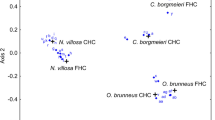Abstract
We present a hitherto unknown prey perception strategy in bats: Myotis nattereri (Vespertilionidae, Chiroptera) is able to perceive prey by echolocation within a few centimeters of echo-cluttering vegetation, by using frequency-modulated search signals of very large bandwidth (up to 135 kHz). We describe the species’ search behavior and echolocation repertoire from the field and from experiments in a flight tent. In the field, bats varied signal parameters in relation to their distance from vegetation and usually flew close to vegetation. In the flight tent, M. nattereri detected and localized prey by echolocation alone as close as 5 cm from vegetation. Apparently, the bats were able to tolerate some overlap between prey and clutter echoes. Passive prey cues (vision, olfaction, prey-generated sounds) were not used in prey perception. The bats selected prey by size. The animals performed aerial catches and produced approach sequences typical for aerial hawking bats, but were able to do so within a few centimeters of the substrate. M. nattereri thus has access to silent, suspended prey very close to vegetation (e.g., spiders, and caterpillars on threads).
Similar content being viewed by others
Author information
Authors and Affiliations
Additional information
Received: 29 September 1999 / Received in revised form: 12 February 2000 / Accepted: 12 February 2000
Rights and permissions
About this article
Cite this article
Siemers, B., Schnitzler, HU. Natterer’s bat (Myotis nattereri Kuhl, 1818) hawks for prey close to vegetation using echolocation signals of very broad bandwidth. Behav Ecol Sociobiol 47, 400–412 (2000). https://doi.org/10.1007/s002650050683
Issue Date:
DOI: https://doi.org/10.1007/s002650050683




